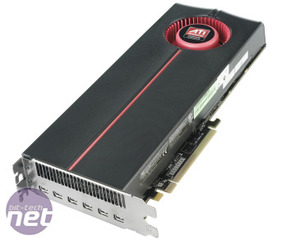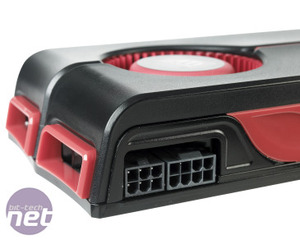
ATI Radeon HD 5870 Eyefinity 6 Review
Manufacturer: ATIUK Price (as reviewed): £428.32 (inc VAT)
US Price (as reviewed): $499.99 (ex tax)
Trawl a few forums for advice on which high-end graphics card to buy at the moment and you’ll likely hit a torrent of scorn that implies you’re wasting your money, that the consoles are holding back PC game engine development and that you’re Hitler in disguise (there’s always someone who has to lower the tone).
Hitler jibes aside, the rest of the criticism is bad news if you’re a graphics card manufacturer, and worse if you make GPUs. The obvious answer to the problem (perceived or real) of stagnation in pixel processing finesse is to develop some kind of technology that raises the number of pixels to process: enter ATI's Eyefinity.
Eyefinity ws introduced back in September 2009, with the first Cypress GPU, which powered the Radeon HD 5870. ATI built three output controllers into the back-end of the GPU, and that let you output to three screens concurrently from one card, so it's something that all standard HD 5870s are capable of.
Crazier still, ATI showed an Eyefinity Edition of the HD 5870, which could output to six screens simultaneously. It’s this card - called the HD 5870 Eyefinity 6 - that we have today and will be looking at.
As this is the only model of graphics card in the world that can run games across six screens, there’s nothing to really compare it to for huge-display gaming, something of a problem if you want real technical analysis of it. We’re also less than convinced that six-screen gaming is a particularly good idea from our first look at Eyefinity. The problem is that with a two x three screen configuration, there will always be a double width of bezel right in your eye-line, which breaks the suspension of disbelief with irritating ease.
ATI says that Samsung is working on bezel-less screens, but Samsung’s PR agency denies any knowledge of such a product, which at best means that such screens aren’t going to arrive any time soon. Even if you have bezel-less screens, there’s a problem is how you turn them on or off or adjust the OSD – presumably the buttons will be on the back of the screen, which means they’ll be awkward to get to if you have six of them mounted edge-to-edge. Even if you’re planning to use low-resolution projectors, three would be fine unless you really fancy playing games as if you’re sitting in the front row of the cinema.
As a result of the fact that six-screen gaming is such an oddity, when it comes to performance testing, in this article, we're going to concentrate on three-screen gaming. This allows us to directly compare the special HD 5870 Eyefinity 6 card with ATI’s existing range.
The Eyefinity 6 card differs from a standard Radeon HD 5870 is two ways. Firstly, it has 2GB of GDDR5 memory rather than 1GB (though this runs at the usual 1.2GHz, or 4.8GHz effective) and secondly, it has six mini-DisplayPort outputs rather than a jumble of standard-szied connections. As mini-DisplayPort ports are so small, ATI can line them up and leave the entire second slot’s worth of backplate clear for a rear cooler vent.
The addition of extra memory obviously leads to an increase in the cost of the card, though we doubt it’s the extra memory alone that accounts for the £110 price difference between a HD 5870 (at £317 inc VAT) and the cheapest Eyefinity 6 card. Part of the high price of an Eyefinity 6 card might be covered by the five adapters that ATI says will be in Eyefinity 6 boxes. There will be two mini-DisplayPort to DisplayPort dongles, two passive mini-DisplayPort to (single-link) DVI dongles and a passive mini-DisplayPort to HDMI dongle.
A passive DisplayPort adapter is one that does no signal conversion work, and so can only be connected to one of the DisplayPort outputs that supports ‘legacy’ connections such as HDMI, DVI and D-Sub. An Eyefinity 6 card has two of these – if you want to use more than two ‘legacy’ connetions, you’ll need to buy an active adapter from ATI’s qualified active DisplayPort adapters list.
Let’s have a quick look at the specs before heading on to how we tested
| Specifications | |||
| ATI Radeon HD 5870 Eyefinity 6 | ATI Radeon HD 5870 | ATI Radeon HD 5970 | |
| Stream processors | 1,600 | 1,600 | 2 x 1,600 |
| Frequency (core) | 850MHz | 850MHz | 725MHz |
| Frequency (SPs) | 850MHz | 850MHz | 725MHz |
| Manufacturing process | 40nm | 40nm | 40nm |
| Texture units | 80 | 80 | 2 x 80 |
| ROPs | 32 | 32 | 2 x 32 |
| Memory | |||
| Memory | 2GB GDDR5 | 1GB GDDR5 | 2 x 1GB GDDR5 |
| Memory Frequency | 1.2GHz (4.8GHz, effective) | 1.2GHz (4.8GHz, effective) | 1GHz (4GHz effective) |
| Memory interface | 256-bit | 256-bit | 2 x 256-bit |
| Memory Bandwidth | 154GB/sec | 154GB/sec | 2 x 128GB/sec |
| Ports and Power | |||
| Connections | 6 x mini-DisplayPort | 2 x dual-link DVI, 1 x DisplayPort, 1 x HDMI, 2 x CrossFire | 2 x Dual-link DVI, mini-DisplayPort |
| Power inputs | 1 x 8-pin, 1 x 6-pin PCI-E | 2 x 6-pin PCI-E | 1 x 8-pin, 1 x 6-pin PCI-E |
| Idle Board Power | 34W | 27W | 51W |
| Max Board Power | 228W | 188W | 294W |
| Recommended PSU | 600W | 500W | 650W |

MSI MPG Velox 100R Chassis Review
October 14 2021 | 15:04












Want to comment? Please log in.